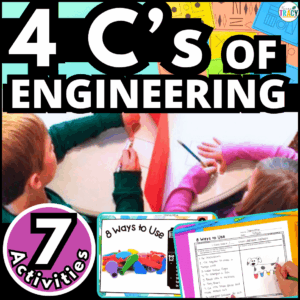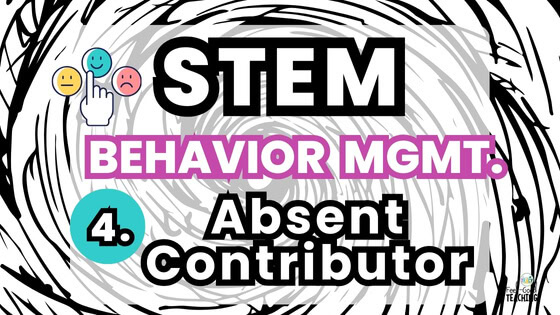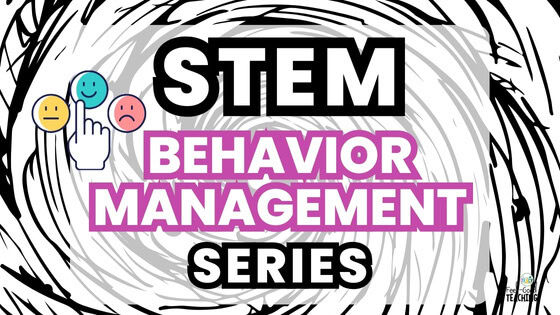Let’s talk about how to re-engage students in STEM. Some kids don’t just hesitate, they disengage. During STEM challenges, these students seem “checked out” entirely. They might stare into space, doodle, chat about unrelated topics, or simply sit with folded arms while their team works.
This post is part of the STEM Classroom Management Behavior Series, where we tackle real-life scenarios educators face during collaborative STEM challenges. Check out the full series for more strategies on building stronger, more collaborative teams.
Meet the Absent Contributor
You launch a STEM challenge, materials are flying, ideas are buzzing… and then you notice a student completely disengaged. They might:
- Drift around the room instead of joining their group
- Stare off into space while others get to work
- Pick up materials but never really use them
- Chat about unrelated topics or disengage entirely
- Doodle or quietly disappear into their own world
Their teammates might glance at them expectantly or simply work around them.
Unlike the Silent Teammate, who’s often listening and thinking but hesitant to speak, the Absent Contributor is mentally elsewhere.
And unlike the openly Apathetic Student, who declares, “This is boring,” the Absent Contributor usually fades quietly into the background.
It’s not defiance, it’s detachment. And unless we understand why, it’s nearly impossible to bring them back in.
Why Students Disengage
When kids disengage, it’s rarely random. Here are a few common reasons you might see this behavior:
Common root causes:
➡️ They feel unnecessary
If teammates dominate decisions or grab materials too quickly, they may assume their ideas aren’t wanted or needed.
➡️ They’re confused or overwhelmed
Fast-paced group work can be challenging for kids who need extra time to process directions or observe before acting.
➡️ They don’t like their assigned role
For me, roles don’t work a lot of the time. If my job is to sketch the design, and I don’t draw well, I’m instantly checked out and annoyed I can’t do something better matched to my skill set. Many students feel the same.
➡️ They fear failure
If they’ve struggled in STEM before, sitting out feels safer than risking a “wrong” answer or “bad” design.
➡️ They don’t see the relevance
Without a personal connection to the topic, their motivation drops. If the challenge doesn’t feel interesting or meaningful, why engage?
➡️ They’re dysregulated
Noise, chaos, and social dynamics can overwhelm some learners, especially neurodivergent kids, making participation harder in the moment.
➡️ They’re preoccupied
Sometimes disengagement isn’t about STEM at all. Hunger, fatigue, stress, trauma, or events at home can weigh heavily on a student’s ability to engage.
📌 If they’re checked out across all subjects and activities, it may signal a bigger issue that warrants compassion and support, possibly from a school counselor.
📌 If disengagement only happens during STEM challenges, however, it’s more likely connected to group dynamics, confidence, or relevance.
Key takeaway: Disengagement is communication. Once we understand the “why,” we can design a better “how” to bring them back in.
Strategies for Supporting The Absent Contributor
Here’s how to support students before, during, and after a challenge to improve engagement for Absent Contributors.
🌍 Before the Challenge: Build Connection & Confidence
1️⃣ Create a Culture of Iteration & Risk-Taking
Normalize failure as part of the STEM learning process. Celebrate mistakes as opportunities to learn and improve. Focus conversations on process, not just outcomes, so kids feel safe taking risks.
If you need some help on this topic, check out this mini-training: Teaching Students HOW to Persevere or the full training: Teaching Productive Failure, Perseverance and Growth Mindset
2️⃣ Use Interest-Driven Hooks
Spark curiosity at the start of each challenge with a short video, surprising fact, or quick demo. Show kids why the challenge matters and help them see themselves in the problem-solving process.
Quick tip: If you ran out of time to prepare this piece, ask students before the challenge to think about why you asked them to do this challenge and how it might connect to real-life as they work.
When the challenge is over, ask them what they came up with (sometimes it’s even better than what you had in mind!)
3️⃣ Offer STEM Choice Menus
Whenever possible, give kids autonomy by letting them choose between two or three possible builds or approaches. Even small choices foster ownership and motivation. Two great resources for providing choice are Stop the Story STEM and Quick Builds.
4️⃣ Co-Create Collaboration Norms
Use your 4 Cs Posters & Reflection Pages to establish shared expectations for communication, collaboration, creativity, and critical thinking. Giving kids the language to describe these skills helps them embody them.
5️⃣ Establish Norms for Regulation Breaks
Build routines around what kids should do when they need a moment to reset. This might include:
➡️ Modeling re-entry strategies so students know how to get back on track
➡️ Teaching kids how to ask for a short break
➡️ Creating a “calm-down corner” stocked with tools to help them regulate
6️⃣ Choose a rubric that supports your goals & share it. Whatever the behavior you want to work on, be sure it’s part of the rubric you’re using to evaluate the challenge. But don’t stop there. Review the rubric before the activity, and have students set goals for themselves and their teams before they begin.
⏱️ During the Challenge: Re-Engage Without Pressure
📌 Spot Signs of Overwhelm Early
Watch for students who are zoning out, fiddling with materials, or letting teammates carry the work. Gently check in:
“Hey, I’ve noticed you’re quiet right now. Do you need a moment or some clarity on what to do next?”
📌 Validate & Reframe
Acknowledge disengagement without judgment:
“It’s okay if you’re stuck or need a break. Let’s find one small thing you can focus on right now.”
📌 Redirect Purposefully
Give them a micro-task they can succeed at quickly, like testing a single design variable, measuring materials, or sketching a next-step idea. A quick win builds momentum.
📌 Offer a Calm Reset Option
If overstimulation is the issue, give students a low-stakes path to regulate:
- Set up a calm-down corner stocked with sensory tools, reflection cards, or even sketch paper.
- Encourage students to pause and breathe, then return when ready.
- Normalize this as a tool, not a punishment.
📌 Use Quick “See–Notice–Think–Wonder” Prompts
Help kids reconnect to the present moment and re-engage their senses. For example:
- See: “What’s one detail about your team’s build right now?”
- Notice: “What part of the process seems most interesting?”
- Think: “What do you think will happen if your team tests this design?”
- Wonder: “What’s one thing you’d like to try next?”
📌 Rubric reminders. As you’re circulating during the challenge, ask where they’d rate themselves now on the rubric for collaboration and whether they can keep up the good work, or make some tweaks to improve before the challenge is over.
🔄 After the Challenge: Reflect & Build Habits
⭐️ Reflect as a Team
Use quick group reflections to revisit collaboration norms and self-assess themselves. Ask:
- “How did we include everyone today?”
- “What helped you stay engaged?”
- “What would make next time smoother?”
⭐️ Debrief Privately When Needed
If you suspect disengagement stems from bigger issues (like stress at home, hunger, or trauma – check in privately and empathetically). You can gently ask:
“I noticed STEM time’s been tough lately. Is this just STEM, or are other subjects feeling hard too?”
⭐️ Highlight Process Over Product
Celebrate curiosity, persistence, and teamwork rather than just the final design. This helps kids feel their contributions are valued even if their ideas weren’t chosen or successful.
⭐️ Close the Loop
Circle back with students who checked out to plan a small, achievable goal for next time. Examples:
- “Next round, your job is to test the first idea.”
- “Pick one material and see how it changes your design.”
⭐️ Normalize Second Chances
If possible, build in do-over opportunities. Kids who disengaged once often show up differently when they understand expectations, feel regulated, and know their role matters.
🧠 Key Takeaways
Disengagement is rarely laziness. It’s usually about feeling unnecessary, overwhelmed, or disconnected.
Curiosity hooks and structured choice are powerful prevention tools
During the challenge, meet students where they are with gentle scripts, grounding exercises, and calm-down options.
Use reflection tools to build awareness, self-confidence, and lasting habits of collaboration.
💡 Want a Free STEM Behaviors SEL Handbook?
I’ve put together a printable copy of these strategies, as well as navigating the other tricky STEM behaviors in this series. It’s perfect for keeping in your lesson planner or sharing at your next PLC or team meeting.
Looking for Student Choice STEM Activities?
For more practice on the 4 Cs of Engineering:

STEM Rubrics and Perseverance Trainings:
✨ Next in the Series…
In our next post, we’ll explore The Distracted Group.
Explore all posts in the STEM Classroom Management Series here.
Pin it. Share it. Save it. Let’s build better teams, one STEM challenge at a time. 🚀
Every challenge is a chance to teach collaboration. Let’s help students disagree productively.









